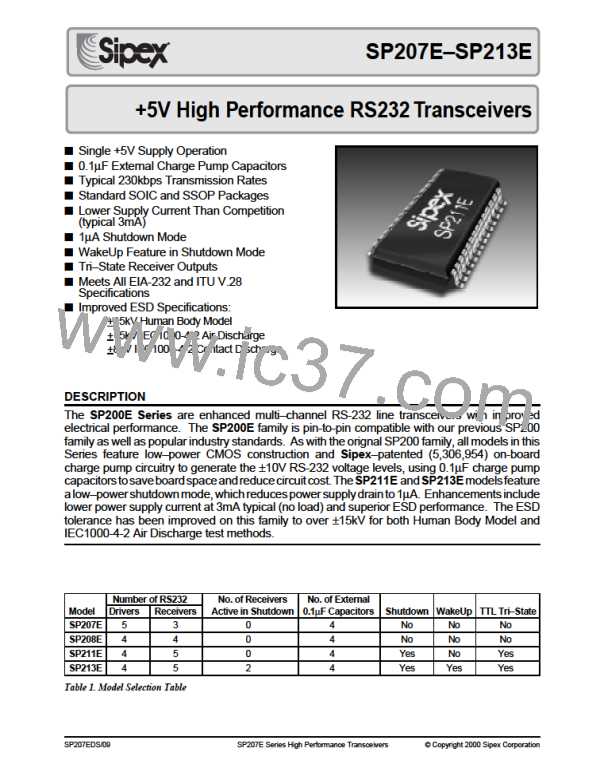There are different methods of ESD testing
applied:
WAKEUP FUNCTION
The SP213E has a wake–up feature that keeps
two receivers (R4 and R5) in an enabled state
when the device is in the shutdown mode. With
only the receivers active during shutdown, the
devices draw 5–10µA of supply current.
a) MIL-STD-883, Method 3015.7
b) IEC1000-4-2 Air-Discharge
c) IEC1000-4-2 Direct Contact
The Human Body Model has been the generally
acceptedESDtestingmethodforsemiconductors.
This method is also specified in MIL-STD-883,
Method 3015.7 for ESD testing. The premise of
this ESD test is to simulate the human body’s
potentialtostoreelectro-staticenergyanddischarge
it to an integrated circuit. The simulation is
performed by using a test model as shown in
Figure7. ThismethodwilltesttheIC’scapability
to withstand an ESD transient during normal
handlingsuchasinmanufacturingareaswherethe
ICs tend to be handled frequently.
A typical application of this function would be
where a modem is interfaced to a computer in a
power–down mode. The ring indicator signal
from the modem could be passed through an
active receiver in the SP213E that is itself in the
shutdownmode.Theringindicatorsignalwould
propagate through the SP213E to the power
management circuitry of the computer to power
up the microprocessor and the SP213E drivers.
After the supply voltage to the SP213E reaches
+5.0V, the SHUTDOWN pin can be disabled,
taking the SP213E out of the shutdown mode.
TheIEC-1000-4-2,formerlyIEC801-2,isgenerally
used for testing ESD on equipment and systems.
For system manufacturers, they must guarantee a
certainamountofESDprotectionsincethesystem
itself is exposed to the outside environment and
human presence. The premise with IEC1000-4-2
is that the system is required to withstand an
amountofstaticelectricitywhenESDisappliedto
points and surfaces of the equipment that are
accessible to personnel during normal usage. The
transceiver IC receives most of the ESD current
when the ESD source is applied to the connector
pins. ThetestcircuitforIEC1000-4-2isshownon
Figure8. TherearetwomethodswithinIEC1000-
4-2, the Air Discharge method and the Contact
Discharge method.
All receivers that are active during shutdown
maintain 500mV (typ.) of hysteresis.
ESD TOLERANCE
The SP207E Family incorporates ruggedized
ESD cells on all driver output and receiver input
pins. The ESD structure is improved over our
previous family for more rugged applications
and environments sensitive to electro-static
discharges and associated transients. The
improved ESD tolerance is at least +15kV
without damage nor latch-up.
R
R
S
S
R
R
C
C
SW2
SW2
SW1
SW1
Device
Under
Test
DC Power
Source
C
C
S
S
Figure 7. ESD Test Circuit for Human Body Model
SP207EDS/09
SP207E Series High Performance Transceivers
© Copyright 2000 Sipex Corporation
9

 SIPEX [ SIPEX CORPORATION ]
SIPEX [ SIPEX CORPORATION ]